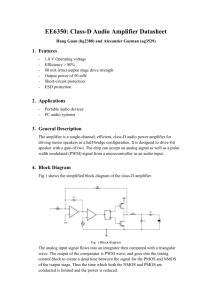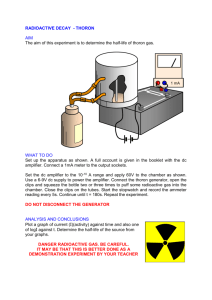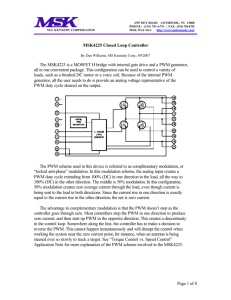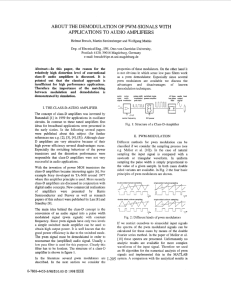130337_amplifier_for_portable_devicex
advertisement
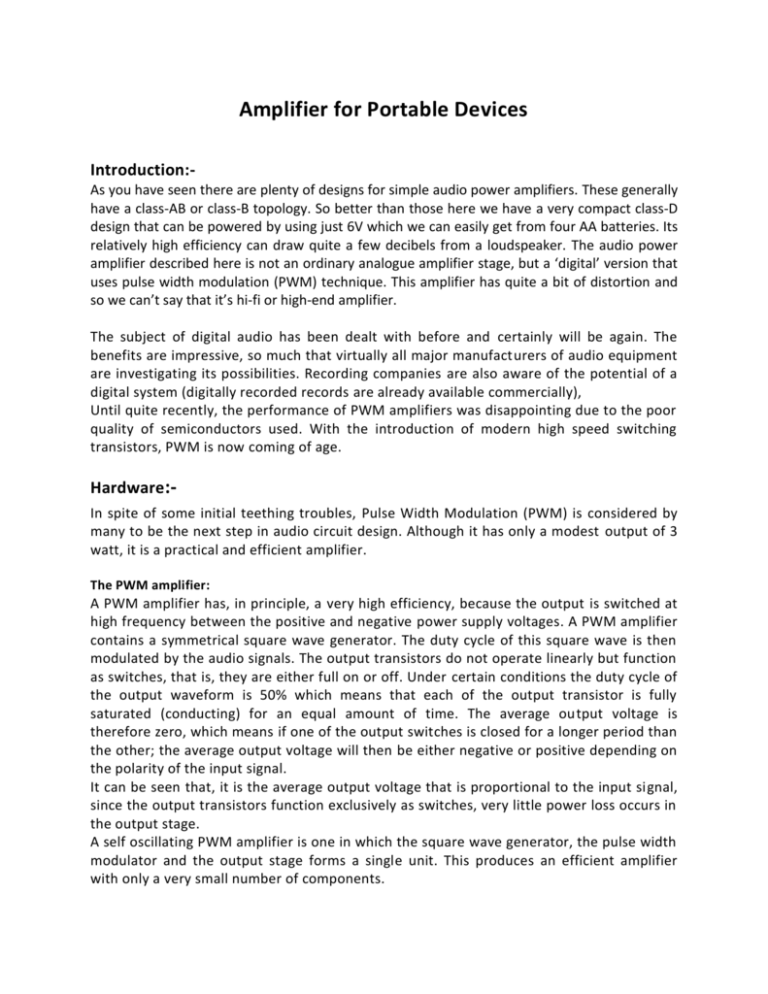
Amplifier for Portable Devices Introduction:As you have seen there are plenty of designs for simple audio power amplifiers. These generally have a class-AB or class-B topology. So better than those here we have a very compact class-D design that can be powered by using just 6V which we can easily get from four AA batteries. Its relatively high efficiency can draw quite a few decibels from a loudspeaker. The audio power amplifier described here is not an ordinary analogue amplifier stage, but a ‘digital’ version that uses pulse width modulation (PWM) technique. This amplifier has quite a bit of distortion and so we can’t say that it’s hi-fi or high-end amplifier. The subject of digital audio has been dealt with before and certainly will be again. The benefits are impressive, so much that virtually all major manufacturers of audio equipment are investigating its possibilities. Recording companies are also aware of the potential of a digital system (digitally recorded records are already available commercially), Until quite recently, the performance of PWM amplifiers was disappointing due to the poor quality of semiconductors used. With the introduction of modern high speed switching transistors, PWM is now coming of age. Hardware:In spite of some initial teething troubles, Pulse Width Modulation (PWM) is considered by many to be the next step in audio circuit design. Although it has only a modest output of 3 watt, it is a practical and efficient amplifier. The PWM amplifier: A PWM amplifier has, in principle, a very high efficiency, because the output is switched at high frequency between the positive and negative power supply voltages. A PWM amplifier contains a symmetrical square wave generator. The duty cycle of this square wave is then modulated by the audio signals. The output transistors do not operate linearly but function as switches, that is, they are either full on or off. Under certain conditions the duty cycle of the output waveform is 50% which means that each of the output transistor is fully saturated (conducting) for an equal amount of time. The average output voltage is therefore zero, which means if one of the output switches is closed for a longer period than the other; the average output voltage will then be either negative or positive depending on the polarity of the input signal. It can be seen that, it is the average output voltage that is proportional to the input signal, since the output transistors function exclusively as switches, very little power loss occurs in the output stage. A self oscillating PWM amplifier is one in which the square wave generator, the pulse width modulator and the output stage forms a single unit. This produces an efficient amplifier with only a very small number of components. Operation:The circuit is far too simple. On the other hand, the circuit does give a unique sound to the music. The digital amplifier has perhaps a ‘tube-like sound’ quality. As in the circuit of the complete amplifier it can be seen that a PWM amplifier need not be very complicated. The input signal is fed to an opamp IC1. This is used as a comparator and is followed by a number of Schmitt triggers in parallel. This has two purposes. Firstly the waveform needs to be a `square' and secondly sufficient base drive current is needed for the output stage which uses two ordinary but fairly fast transistors (BD 137/138). The entire amplifier oscillates and produces a square wave. This is because one of the inputs of the comparator (IC1) is connected to the output by means of an RC network. Both inputs of IC1 are biased to one half of the supply voltage using voltage divider R3/R4. Whenever the output of IC1 is low and the emitters of T1/T2 are high, capacitor C3 is charged by way of R7 and the voltage rises at the non-inverting input. If it rises above the level of the inverting input, IC1's output changes low to high and the emitters of T1/T2 change from high to low. As a result, C3 is now discharged through R7, the voltage at the positive input drops below that of the negative input and the output of IC1 switches back to a low state. The result is a square wave output; the frequency of which is determined by R7 and C3. The values given result in an oscillation at 700 kHz. Provided Murphy doesn't get in the way, we should have an oscillator. Now we have to pulse width modulate it. The level at the inverting input of IC1, which is used as a reference, does not remain constant but is determined by the audio signal. The point at which the output of the comparator changes, is also determined by the amplitude, as a result the width of the square wave is constantly changed (modulated) by the audio signal. At the output of the amplifier, filtering is required: it is not supposed to act as a 700 kHz transmitter. An LC/RC network is used, consisting of L1/C6 and C7/R6, With a load of 8 ohms and a supply voltage of 12 volts, the amplifier produced 1.6 watts, At 4 ohms, 3 watts were measured. Cooling the output transistor was not necessary. The harmonic distortion proved to be surprisingly low for such a simple design. Less than 0.32"% total harmonic distortion from 20 Hz-20 kHz was measured.
